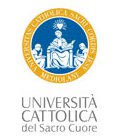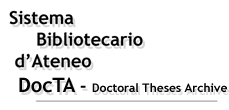|
|
DocTA - Doctoral Theses Archive >
Tesi di dottorato >
CORSO DI DOTTORATO IN ISTITUZIONI E POLITICHE >
Citazione:
Utilizza queste indicazioni per citare o creare un link a questo documento.
|
Cinciripini, Luca. "L'INTERAZIONE TRA UE E NATO NELLA COSTRUZIONE DEL REGIME EUROPEO DI DIFESA", Università Cattolica del Sacro Cuore, XXXV ciclo, a.a. 2021/22, Milano, [http://hdl.handle.net/10280/172660].
|
| Titolo: | L'INTERAZIONE TRA UE E NATO NELLA COSTRUZIONE DEL REGIME EUROPEO DI DIFESA |
| Autore/i: | CINCIRIPINI, LUCA |
| Tutor: | CASTELLIN, LUCA GINO
ZOTTI, ANTONIO |
| Coordinatore: | COLOMBO, PAOLO |
| Lingua: | ITA |
| Abstract in italiano della tesi: | La ricerca ha l’obiettivo di approfondire i meccanismi di interazione tra organizzazioni internazionali circoscrivendo l’indagine al regime europeo di difesa e osservando tali processi tra UE e NATO applicando la categoria delle pratiche giuridiche. La domanda a cui la ricerca vuole rispondere è se siano rinvenibili pratiche giuridiche nel quadro di tali rapporti e in che misura il diritto, agendo come fattore di interazione tra attori, sia in grado di modellare tali processi e il regime che ne deriva. La duplice prospettiva, giuridica e politica, consente di analizzare la natura delle organizzazioni internazionali non solo attraverso gli aspetti istituzionali e politici ma anche approfondendone la natura giuridica allo scopo di integrare gli studi istituzionalisti della politica estera e di sicurezza in ambito europeo. Nella prima parte, lo studio presenta una rassegna dei principali fondamenti teorici elaborati dalla letteratura politologica, inquadrando le specifiche caratteristiche delle pratiche. Nella seconda parte, invece, questo impianto teorico viene applicato presentando i risultati di interviste svolte con funzionari di entrambi gli enti e delegati presso le rappresentanze Permanenti degli Stati membri. Questi dati empirici verranno poi integrati con una serie di esempi concreti di pratiche sviluppatesi nel tempo tra UE e NATO e operanti su tre diversi livelli: burocratico, politico e giuridico. La metodologia è basata su una raccolta qualitativa di documenti ufficiali, trattati e letteratura secondaria elaborata sul tema, combinata con dati empirici rilevati per mezzo di interviste semi-strutturate. L’emergere di nuovi attori non-statali, come i gruppi terroristici, o il ricorso a forme di hybrid warfare capaci di integrare i classici strumenti militari, richiedono un profondo ripensamento della ripartizione dei compiti tra UE e NATO nell’ambito della difesa europea. Questa crescente minaccia si propone di sfruttare le zone grigie del diritto internazionale e del quadro giuridico internazionale, inserendosi in un contesto di tensione tra UE e NATO che porta a sviluppare forme di cooperazione ma anche di rivalità tra le due organizzazioni. Ciò rende ancor più necessario indagare non solo i meccanismi di interazione tra organizzazioni, ma anche i punti di contatto esistenti tra diritto internazionale e Relazioni internazionali, allo scopo di approfondire i legami esistenti e avvicinare le due discipline. |
| Abstract in inglese: | The aim of this research is to investigate the interaction mechanisms between international organizations in the European defence regime, specifically between the EU and NATO, by examining legal practices. The research question is whether legal practices are present in these relationships and to what extent the law, as a factor of interaction between actors, can influence these processes and the resulting regime. The dual legal and political perspective enables an analysis of international organizations that encompasses both their institutional and political aspects, as well as their legal nature. This approach integrates institutionalist studies of foreign and security policy within the European context. The first part of the study provides a review of the main theoretical issues developed by political science literature, framing the specific characteristics of the practices. The second part of this document applies the theoretical framework by presenting interview results from officials of both bodies and delegates at the Permanent Representations of the member states. These empirical data will be complemented with concrete examples of practices developed over time between the EU and NATO, operating on three different levels: bureaucratic, political, and legal. The methodology is based on a qualitative collection of official documents, treaties, and secondary literature related to the topic, combined with empirical data collected through semi-structured interviews. The emergence of new non-state actors, such as terrorist groups, or the use of forms of hybrid warfare capable of complementing classical military instruments, calls for a profound rethinking of the division of tasks between the EU and NATO in the area of European defence. This threat is growing and takes advantage of the ambiguous areas within the international legal framework. It occurs within a context of tension between the EU and NATO, which leads to the development of both cooperative and competitive forms of interaction between the two organizations. Therefore, it is essential to investigate not only the mechanisms of interaction between organizations but also the existing points of contact between international law and international relations. This will deepen the existing links and bring the two disciplines closer. |
| Data di discussione: | 26-gen-2024 |
| URI: | http://hdl.handle.net/10280/172660 |
| È visualizzato nelle collezioni: | CORSO DI DOTTORATO IN ISTITUZIONI E POLITICHE
FACOLTA' DI SCIENZE POLITICHE
|
File in questo documento:
| File |
Dimensioni | Formato | Accessibilità |
|---|
| tesiphd_completa_Cinciripini.pdf | 1,3 MB | Adobe PDF | non consultabile
|
|
Accesso e utilizzo dei contenuti di DocTA
|



